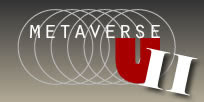Metaverse U '09 - All about the open virtual space

This past weekend was the second iteration of Metaverse U put on by Henrik Bennetsen at Stanford University. The Metaverse U conference took place at Stanford University on May 29 th and 30 th . The goal of this years conference was to explore the cutting edge applications of virtual worlds and the open platforms that drive them. Henrik gathered an impressive lineup of speakers and I will embed their videos here once they go online. Some highlights from the presentations: Sirikata , Stanford's open source platform for virtual worlds, had a high representation this year with a demo that showed some of its editing features. Jeffrey T. Schnapp (Stanford University) talked about cultural heritage with virtual worlds stating "museums are the original 3D world" and the need to embrace (inter)active models of educational programming with an emphasis on bottom-up counterparts to traditional top-down approaches. John Hurliman (Intel) presented Cable Beach, a service based a...
